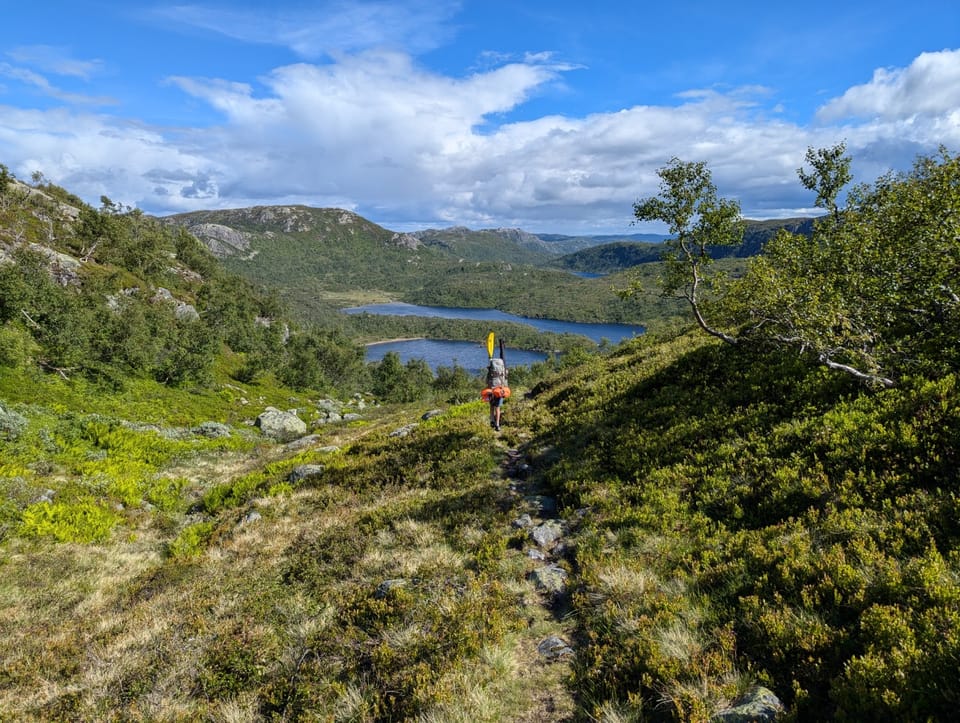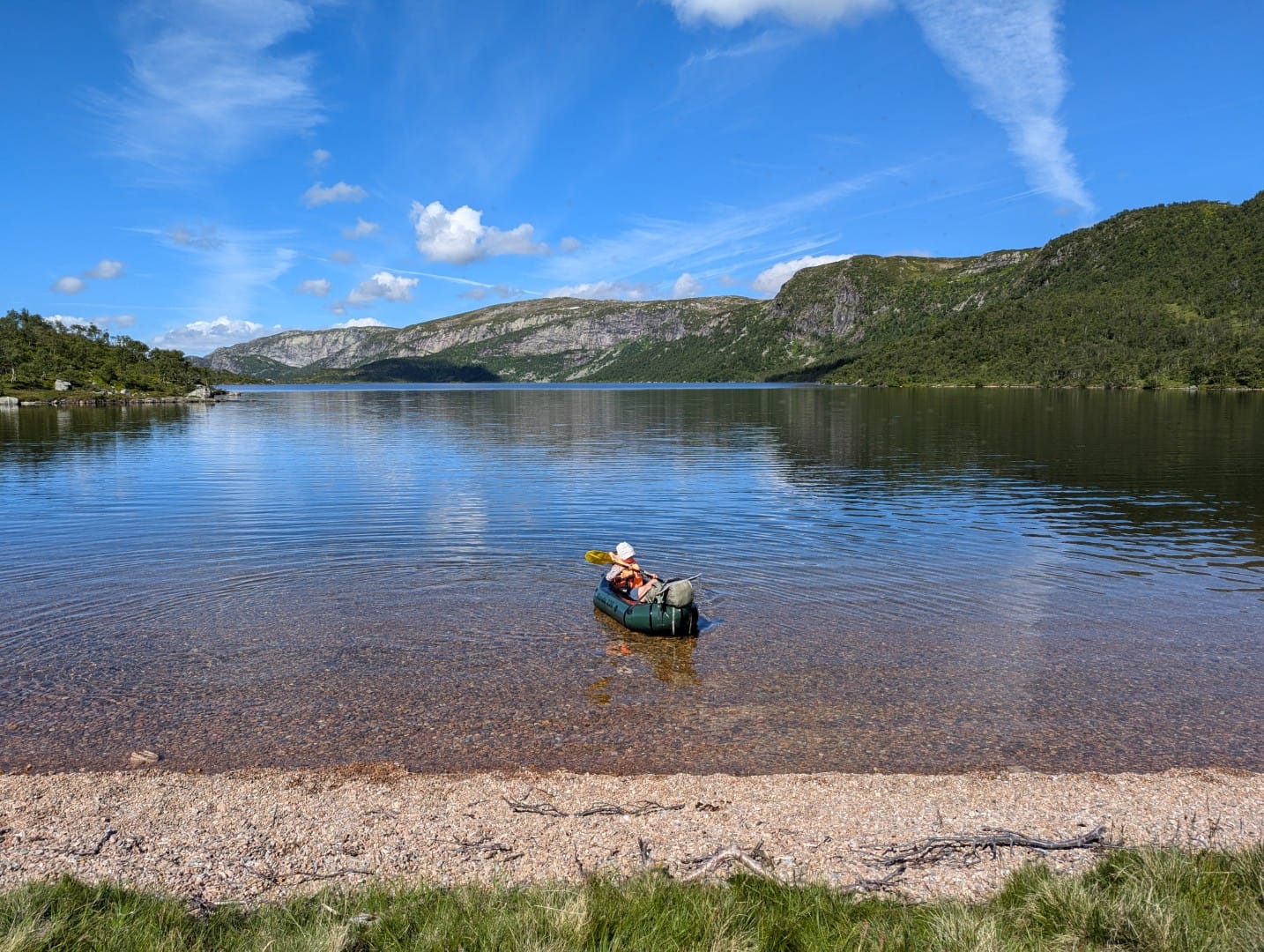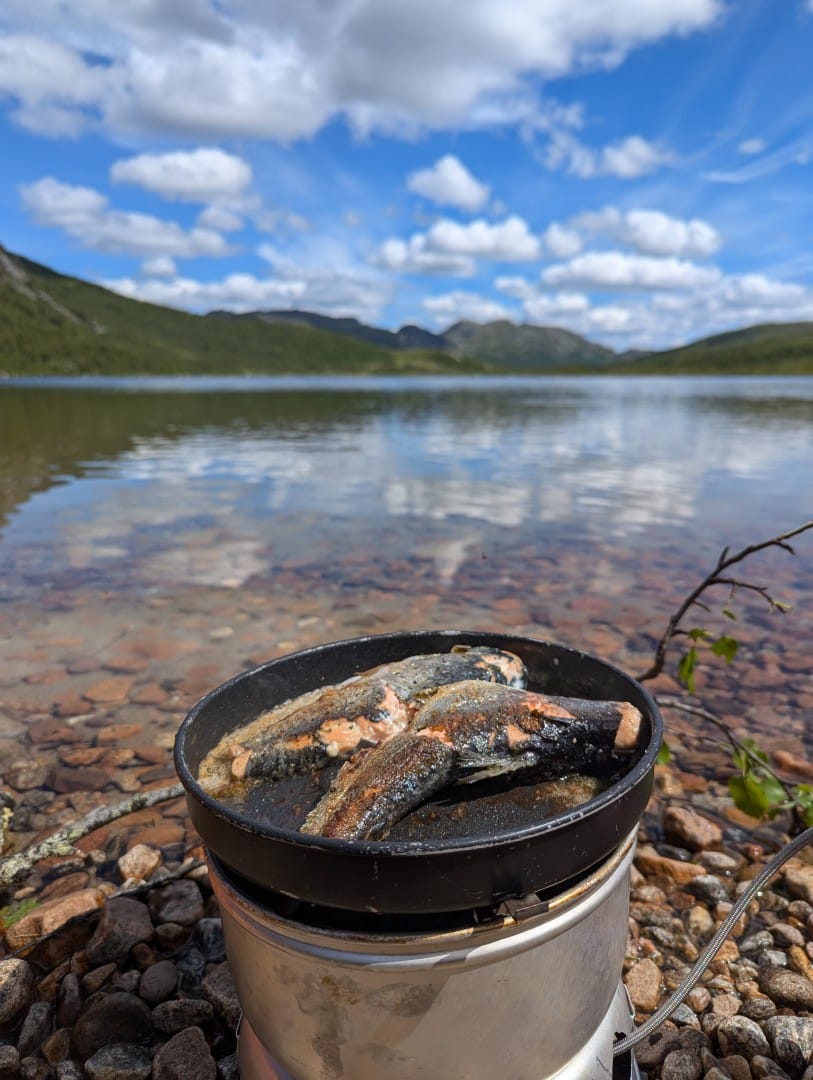First Real Packraft Trip

Our first packraft trip was quiet, simple, and unforgettable. It took place in a remote part of Norway—across connected forest lakes with no signs, no crowds, and no reception. This is a short write-up of the experience we had together, father and son.
We had planned the trip carefully, just the two of us—my oldest son and I. His first real packrafting adventure.
Two nights out, with fishing rods packed alongside chocolate, heavy backpacks, and no real schedule.
We were looking for slow time, quiet water, and the kind of rhythm you don't find at home.
Day 1: Hiking In With Packrafts and Heavy Packs
The hike in wasn’t long—about four kilometres—but with roughly 300 meters of elevation gain, it made itself known.
The packs were heavy, filled with tents, food, and the unfamiliar bulk of two packrafts.
Every step carried its own weight, but the trail was clear, and we made steady progress through the rolling hills.
The final descent, dropping about 200 meters down to the lake, gave us our first real glimpse of the water.
It lay still and silver between the trees, framed by the green of early summer.
We reached the campsite in the late afternoon, tired, sweaty, but already feeling the shift that comes from stepping out of the familiar.
The lake sat calm in a wide, sheltered bay. The ground was dry and grassy, and a coarse gravel beach made for easy swimming—and good casting.
Camp Setup, Failed Fishing, and a Quiet Evening
We set up camp and got the rods out almost immediately.
We tried everything—spinners, spoons, hooks in different colours and sizes. Nothing worked.
The lake was wide and still, the shoreline open and clean, but the fish stayed out of sight.
We moved along the edge, tried deeper water, changed lures, slowed down. Still nothing.
Eventually, we gave up. Made a simple meal, boiled water for tea, and shared a few squares of chocolate.
It wasn’t the fishing evening we had imagined, but the stillness around us made up for it.
After dinner, we sat by the tent, watching the sun drift lower behind the ridgeline.
The lake reflected the sky in gold and amber.
We said little, just watched. Boots off, feet out. The quiet did the talking.
Morning Stillness — and Too Many Midges
Morning brought a different kind of stillness.
No wind, no ripples, not even a whisper in the trees. And with that: midges.
Thousands of them, drifting and biting.
We ate standing, coffee in hand, packing up quickly to escape the cloud.
My son, somehow unaffected, kept fishing while I worked to strike camp.
Just as we were ready to launch the rafts, he caught one—a solid, clean trout.
We packed it cool for later and pushed off across the water.

Packrafting Between Lakes and Catching Trout
The second day was meant for movement.
We crossed the first lake slowly, fishing as we went, drifting close to the shoreline.
This time, luck turned in our favour. Several trout, firm and fresh, were caught along the way.
Before the portage began, we stopped at a small clearing to cook lunch.
The best of the morning’s catch was fried over the stove—crisp skin, tender meat, eaten with fingers still cold from the lake.
It was one of those meals you don't forget.

After lunch, we packed down the rafts and carried them for about a kilometre along a narrow, downhill trail.
The forest closed in slightly, the sound of water always just out of sight.
At the start of the next lake, we launched again for a short final crossing before reaching our second campsite.
The shoreline was quiet, the ground flat, and a light breeze kept the midges away.
We set up camp, cooked a simple meal, and let the evening settle around us.
Final Morning: Wind, Rain, and the Walk Out
Sometime during the night, the weather shifted.
We woke to rain drumming against the tent and the steady tug of wind through the trees.
The temperature had dropped, and the lake had turned grey and restless.
We packed carefully, thankful that we didn’t need to paddle again.
Waves rolled across the water, large enough to make packrafting unsafe—especially with a child.
The walk back toward the road was slick and slow.
Rain found its way through seams and cuffs.
The trail, dry just two days earlier, had become a line of mud and stones.
We didn’t speak much on the way out.
There was only the sound of boots on wet ground and the steady rhythm of movement.
We reached the car soaked and cold—but smiling.
What This Packraft Trip Taught Me
It had been exactly what we hoped for—a mix of effort, quiet, and time together.
We hadn’t seen a single person during the trip. Only midges, a few sheep, and birds overhead.
I was proud of my son. The weight he carried, the weather he endured, the easy smile he kept throughout.
These are the kinds of days that shape you.
Mapped Route and How to Get It
This route is mapped.
A few copies are available for those interested.
Only a few will know where it is.
Thank you for keeping it that way.
Please keep it whispering.
Wild Reindeer: Seasonal Access Advice
During an earlier trip in this area, I encountered a herd of wild reindeer.
It was a rare and powerful experience—seeing them move silently across the open ground, part of the landscape itself.
Moments like that stay with you.
Extra care is needed when visiting this area in May and early June.
This is the sensitive calving season for wild reindeer, and moving quietly, with distance, helps protect these fragile herds.